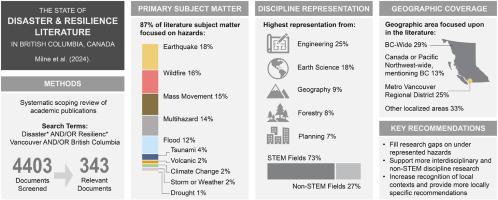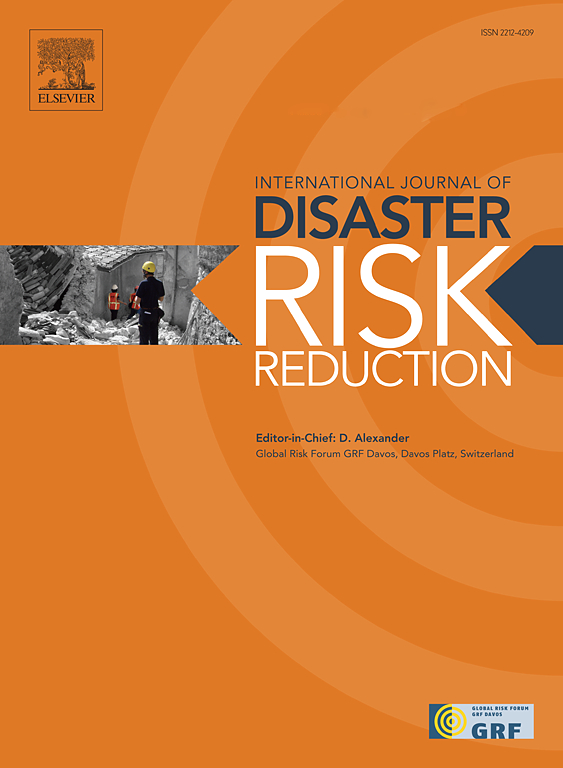The state of disaster and resilience literature in British Columbia, Canada. A systematic scoping review
IF 4.2
1区 地球科学
Q1 GEOSCIENCES, MULTIDISCIPLINARY
International journal of disaster risk reduction
Pub Date : 2024-10-15
DOI:10.1016/j.ijdrr.2024.104848
引用次数: 0
Abstract
British Columbia (BC), Canada is exposed to diverse natural hazards, leading to extensive research into disaster and resilience topics in the province. However, within disaster studies there is commonly siloing of research and knowledge between different fields, hindering integrated risk reduction solutions. This review aims to summarize the current state of disaster and resilience research in BC to provide context for future innovative research and response efforts. A systematic scoping review was used to balance the need for quantitative and qualitative analysis. 24 databases were systematically searched, and additional records were added from a Google Scholar scan and recommendations from disaster researchers. In total 4403 records were screened, of which 343 documents were analyzed. 87% of documents named a natural hazard type/s as the primary subject matter, while 13% discussed disaster and resilience more generally. Earthquakes were the most frequently discussed hazard, while storm/weather and drought were the least. STEM disciplines published the most on the reviewed themes (73% of documents). A spatial disjuncture was found between locations discussed in the literature versus historic BC disaster trends. Overall, there were several hazards, scales and disciplines that were underrepresented. Furthermore, there was a trend towards application of methods and findings primarily to inform global conversations, missing opportunities to provide local or regional recommendations, or deeper acknowledgements of cultural and historical contexts. This review highlights strengths and gaps in the current disaster and resilience publications in BC and adds to the growing literature on the importance of interdisciplinary and place-based disaster research.

加拿大不列颠哥伦比亚省的灾害和复原力文献现状。系统范围审查
加拿大不列颠哥伦比亚省(BC)面临着各种自然灾害,因此该省对灾害和抗灾能力课题进行了广泛的研究。然而,在灾害研究中,不同领域之间的研究和知识通常各自为政,阻碍了综合风险降低解决方案的实施。本综述旨在总结不列颠哥伦比亚省灾害和抗灾能力研究的现状,为未来的创新研究和应对工作提供背景资料。为了平衡定量分析和定性分析的需要,我们采用了系统性的范围界定综述。我们系统地搜索了 24 个数据库,并根据谷歌学术扫描和灾害研究人员的建议增加了其他记录。共筛选出 4403 条记录,并对其中 343 份文件进行了分析。87%的文献将自然灾害类型作为主要主题,13%的文献更广泛地讨论了灾害和抗灾能力。地震是讨论最多的灾害,而风暴/天气和干旱则最少。科学、技术、工程和数学学科发表了最多关于审查主题的文章(占文件的 73%)。文献中讨论的地点与不列颠哥伦比亚历史灾害趋势之间存在空间差异。总体而言,有几种灾害、规模和学科的代表性不足。此外,还有一种趋势是,应用方法和研究结果主要是为全球对话提供信息,而缺少提供地方或区域建议的机会,或缺少对文化和历史背景的更深刻认识。本综述强调了不列颠哥伦比亚省现有灾害和抗灾出版物的优势和不足,并补充了有关跨学科和基于地方的灾害研究的重要性的文献。
本文章由计算机程序翻译,如有差异,请以英文原文为准。
求助全文
约1分钟内获得全文
求助全文
来源期刊

International journal of disaster risk reduction
GEOSCIENCES, MULTIDISCIPLINARYMETEOROLOGY-METEOROLOGY & ATMOSPHERIC SCIENCES
CiteScore
8.70
自引率
18.00%
发文量
688
审稿时长
79 days
期刊介绍:
The International Journal of Disaster Risk Reduction (IJDRR) is the journal for researchers, policymakers and practitioners across diverse disciplines: earth sciences and their implications; environmental sciences; engineering; urban studies; geography; and the social sciences. IJDRR publishes fundamental and applied research, critical reviews, policy papers and case studies with a particular focus on multi-disciplinary research that aims to reduce the impact of natural, technological, social and intentional disasters. IJDRR stimulates exchange of ideas and knowledge transfer on disaster research, mitigation, adaptation, prevention and risk reduction at all geographical scales: local, national and international.
Key topics:-
-multifaceted disaster and cascading disasters
-the development of disaster risk reduction strategies and techniques
-discussion and development of effective warning and educational systems for risk management at all levels
-disasters associated with climate change
-vulnerability analysis and vulnerability trends
-emerging risks
-resilience against disasters.
The journal particularly encourages papers that approach risk from a multi-disciplinary perspective.
 求助内容:
求助内容: 应助结果提醒方式:
应助结果提醒方式:


